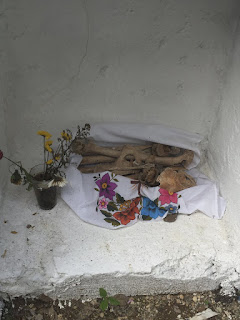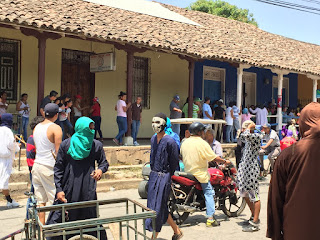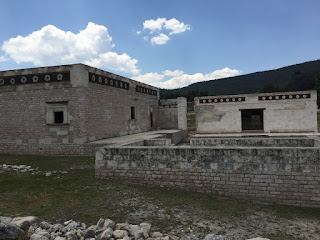 |
| Open grave readied for Dia de los Muertos, Pomuch Campeche, MX |
If one of the psychological purposes of Dia de los Muertos is to bring you face to face with death, there is no better place to do it than Pomuch. The event in Pomuch, a small town in the Mexican state of Campeche, lacks the sugar-coating of the gorgeous festivities of Oaxaca's famed celebration, but it is a stark reminder of what will eventually happen to all of us. The Mexican state of Campeche is on the west coast of the Yucatan peninsula and Pomuch is a small town about 50 minutes outside of San Francisco de Campeche, the state's capital. The uniqueness of its Dia de los Muertos celebration is rooted in the burial practices of the town.
Burial Practices:
The claim is made that Pomuch has burial practices that are unique in all the world.
 |
| Sign at gate of Pomuch cemetery, Pomuch Campeche, MX |
As in many places in Mexico and elsewhere, Pomuch's cemetery is small and burial space is at a premium. Bodies are, initially, buried in full-size tombs, as below.
 |
| Full-length grave in Pouch's cemetery, Pomuch Campeche MX |
They are left there for a minimum of three years until they, hopefully, decompose; sometimes they do not fully decompose, which is strange to see. After this process, if the space is needed, the bones are consolidated into a small ossuary and put into a smaller tomb. Some of these smaller spaces are completely closed-in.
This type of ossuary burial can be seen in many places in Mexico where space is limited. However in Pomuch there is the unique twist that many tombs are open-fronted so that the bones and sometimes hair of the deceased are in plain view.
Once in a while, for various reasons, a body does not fully-decomposed and when it is disinterred looks more like a mummy than a skeleton. A man working in the cemetery told me that this is due to medications that the deceased had been taking at the time of death; I could not verify this.
Origins of these Practices:
There is nothing written that I have been able to find about Pomuch's burial practices, apart from fairly sketchy tourism pieces on the internet. These claim that it is a Mayan custom, which seemed somewhat questionable since the people of the most of the small towns in Campeche are largely of Mayan descent and none of them have this practice of open caskets and the below-described "bone washing" on Dia de los Muertos.
There is some interesting and, perhaps, relevant information in a very old book by Fr. Diego de Landa, the 17th century grand-inquisitor of the Yucatan who was responsible for the burning of the Yucatec Mayan Codices in Mani. Perhaps to make amends for his near-annihilation of written Mayan cultural heritage (just two of these books remain), he wrote a book describing various aspects of the Yucatec Mayan culture at the time of the Conquest. In it he discussed a certain post-mortem practice in which the bones of the skull were cleaned and the cranium kept on display on a kind of altar. This would seem relevant to the practices observed in Pomuch, but there is no proof that there is a connection between the two customs. No one in Pomuch seems to how their burial and Dia de los Muertos "bone-washing" evolved.
Celebrating Dia de los Muertos:
The fact that the ossuaries are open and bones visible is not the crux of Dia de los Muertos in Pomuch- these bones are visible all year round and, contrary to mistaken internet reports, the cemetery in Pomuch is open and accessible 365 days a year, according to the keeper of the town's blog. What makes it Dia de los Muertos is what is done with these bones.
As you can see, bones are laid in an open box lined with an embroidered cloth. In October, before the days of the holiday, November 1 and 2, the cloths are changed for new ones and the bones themselves are cleaned. Again, the internet has it wrong, there is no "bone-washing" as is typically claimed in Pomuch, but a careful brushing of bones by family members.
The woman in the photo was brushing-off the bones of her grandmother. This cleaning is said to be done to preserve the bones. It is done matter-of-factly with a kind of intimacy.
Apart from bone-brushing, as throughout Mexico, the graves themselves receive special treatment; the exterior painting is freshened, and flowers placed around and inside the tombs. The cloths that line the caskets are changed for new ones.
A rattle had been touchingly placed in this baby's casket.
As is customary throughout Mexico, candles are also placed on graves, here among the several caskets in the open tomb.
Relationship with the Dead:
Throughout Mexico, the spirits are believed to return to visit the earthly realm on the Dias de los Muertos, November 1 for children and November 2 for adults. Although, on the surface, the holiday is the same in Pomuch as in the rest of Mexico, there seems to be a different kind of relationship to the dead.
The man in the photo above is holding the bones of his grandmother and for him, these bones are his grandmother. As a child, he said that when he was upset he would come to the cemetery and talk to her (her bones).
The man below, holding his grandfather's skull, mirrored these same sentiments. There was no sense of these bones really being dead; they were a part of a once-living and beloved family member.
A very old, fragile woman wearing a traditional loose white embroidered dress was walking through the cemetery surrounded and supported by family members. She, apparently had been a teacher and one of her group cheerfully pointed to a casket of bones saying, " He was one of your students." This is the outlook of people there and there is not a firm line between living person and dead bone, they are both bear the identity of the person to whom they belonged and this does not stop with death.
The people of Pomuch are not death-obsessed. The town's blog-keeper with whom I corresponded wrote that the cemetery is typically visited primarily in October prior to Dia de los Muertos and on these holidays. Yet, for some of them, the dead seem closer, more a part of everyday life, than in other locales. In Pomuch, the graves are open all year long, not just on Dia de los Muertos, and so, in some way, the dead are always there
not just for an annual visit on November 1 or 2.
Dia de los Muertos and the Human Psyche:
Dia de los Muertos is a holiday with deep psychological significance, in addition to it's ritual and social meaning. Collectively it is a way for the dead to remain a part of the community of the living and has historical precedents both within Christianity and indigenous beliefs. Individually, it also has the purpose of helping individuals face and cope with the idea of death, something that is a 100% sure event for all human beings.
In the typical Dia de los Muertos celebration there are pervasive symbols of death. Altars are built to honor the dead and people paint themselves to look skeletons.
But there is great deal of difference between looking at someone painted like a skeleton and looking at a real one.
The people of Pomuch who choose to have open graves seem very comfortable with the situation and are very matter-of-fact about dealing with the bones of deceased family members. I asked a few people about their feelings and all of them indicated that they did not see any difference between the bones of a person and the person him or herself. For the man holding the bones of his grandmother, the bones were his grandmother and everyone questioned answered along the same lines.
 |
| Closed grave in Pomuch's cemetery, Pomuch Campeche, MX |
This type of ossuary burial can be seen in many places in Mexico where space is limited. However in Pomuch there is the unique twist that many tombs are open-fronted so that the bones and sometimes hair of the deceased are in plain view.
 |
| Group of open graves in Pomuch's cemetery, Pomuch, Campeche MX |
 |
| Cemetery, Pomuch Campeche MX |
 |
| Open grave, Pomuch, Campeche MZ |
 |
| Grave with new embroidered cloth for Dia de los Muertos, Pomuch, Campeche MX |
 |
| Open grave, Pomuch Campeche MX |
Once in a while, for various reasons, a body does not fully-decomposed and when it is disinterred looks more like a mummy than a skeleton. A man working in the cemetery told me that this is due to medications that the deceased had been taking at the time of death; I could not verify this.
 |
| Incompletely decompsed skeleton, Pomuch, Campeche, MX |
Origins of these Practices:
There is nothing written that I have been able to find about Pomuch's burial practices, apart from fairly sketchy tourism pieces on the internet. These claim that it is a Mayan custom, which seemed somewhat questionable since the people of the most of the small towns in Campeche are largely of Mayan descent and none of them have this practice of open caskets and the below-described "bone washing" on Dia de los Muertos.
There is some interesting and, perhaps, relevant information in a very old book by Fr. Diego de Landa, the 17th century grand-inquisitor of the Yucatan who was responsible for the burning of the Yucatec Mayan Codices in Mani. Perhaps to make amends for his near-annihilation of written Mayan cultural heritage (just two of these books remain), he wrote a book describing various aspects of the Yucatec Mayan culture at the time of the Conquest. In it he discussed a certain post-mortem practice in which the bones of the skull were cleaned and the cranium kept on display on a kind of altar. This would seem relevant to the practices observed in Pomuch, but there is no proof that there is a connection between the two customs. No one in Pomuch seems to how their burial and Dia de los Muertos "bone-washing" evolved.
Celebrating Dia de los Muertos:
The fact that the ossuaries are open and bones visible is not the crux of Dia de los Muertos in Pomuch- these bones are visible all year round and, contrary to mistaken internet reports, the cemetery in Pomuch is open and accessible 365 days a year, according to the keeper of the town's blog. What makes it Dia de los Muertos is what is done with these bones.
As you can see, bones are laid in an open box lined with an embroidered cloth. In October, before the days of the holiday, November 1 and 2, the cloths are changed for new ones and the bones themselves are cleaned. Again, the internet has it wrong, there is no "bone-washing" as is typically claimed in Pomuch, but a careful brushing of bones by family members.
 |
| Woman cleaning grandmother's bones in preparation of Dia de los Muertos, Pomuch, Campeche MX |
The woman in the photo was brushing-off the bones of her grandmother. This cleaning is said to be done to preserve the bones. It is done matter-of-factly with a kind of intimacy.
Apart from bone-brushing, as throughout Mexico, the graves themselves receive special treatment; the exterior painting is freshened, and flowers placed around and inside the tombs. The cloths that line the caskets are changed for new ones.
 |
| Grave readied for Dia de los Muertos, Pomuch, Campeche MX |
 |
| Grave readied for Dia de los Muertos, Pomuch, Campeche, MX |
 |
| Grave readied for Dia de los Muertos, Pomuch, Campeche, MX |
 |
| Open grave, readied for Dia de los Muertos, Campeche MZ |
A rattle had been touchingly placed in this baby's casket.
 |
| Baby's grave, Pomuch, Campeche, MX |
As is customary throughout Mexico, candles are also placed on graves, here among the several caskets in the open tomb.
 |
| Open grave, Pomuch, Campeche, MX |
Relationship with the Dead:
 |
| Gate of Pomuch's Cemetery, Pomuch, Campeche |
Throughout Mexico, the spirits are believed to return to visit the earthly realm on the Dias de los Muertos, November 1 for children and November 2 for adults. Although, on the surface, the holiday is the same in Pomuch as in the rest of Mexico, there seems to be a different kind of relationship to the dead.
 |
| Man holding grandmother's bones, Pomuch, Campeche, MX |
The man in the photo above is holding the bones of his grandmother and for him, these bones are his grandmother. As a child, he said that when he was upset he would come to the cemetery and talk to her (her bones).
The man below, holding his grandfather's skull, mirrored these same sentiments. There was no sense of these bones really being dead; they were a part of a once-living and beloved family member.
 |
| Man holding grandfather's skull, Pomuch, Campeche, MX |
A very old, fragile woman wearing a traditional loose white embroidered dress was walking through the cemetery surrounded and supported by family members. She, apparently had been a teacher and one of her group cheerfully pointed to a casket of bones saying, " He was one of your students." This is the outlook of people there and there is not a firm line between living person and dead bone, they are both bear the identity of the person to whom they belonged and this does not stop with death.
The people of Pomuch are not death-obsessed. The town's blog-keeper with whom I corresponded wrote that the cemetery is typically visited primarily in October prior to Dia de los Muertos and on these holidays. Yet, for some of them, the dead seem closer, more a part of everyday life, than in other locales. In Pomuch, the graves are open all year long, not just on Dia de los Muertos, and so, in some way, the dead are always there
not just for an annual visit on November 1 or 2.
Dia de los Muertos and the Human Psyche:
Dia de los Muertos is a holiday with deep psychological significance, in addition to it's ritual and social meaning. Collectively it is a way for the dead to remain a part of the community of the living and has historical precedents both within Christianity and indigenous beliefs. Individually, it also has the purpose of helping individuals face and cope with the idea of death, something that is a 100% sure event for all human beings.
In the typical Dia de los Muertos celebration there are pervasive symbols of death. Altars are built to honor the dead and people paint themselves to look skeletons.
 |
| Halloween Night Celebration, Campeche, MX |
 |
| Skeleton, Pomuch Campeche, MX |
The people of Pomuch who choose to have open graves seem very comfortable with the situation and are very matter-of-fact about dealing with the bones of deceased family members. I asked a few people about their feelings and all of them indicated that they did not see any difference between the bones of a person and the person him or herself. For the man holding the bones of his grandmother, the bones were his grandmother and everyone questioned answered along the same lines.





















































